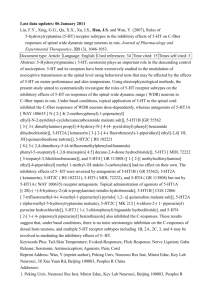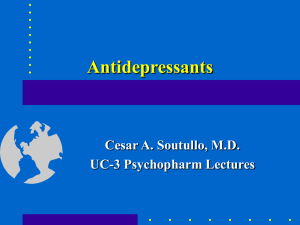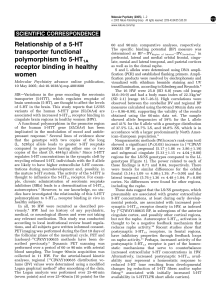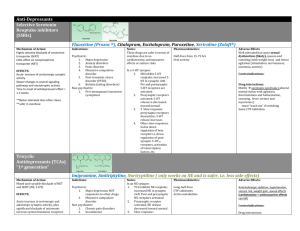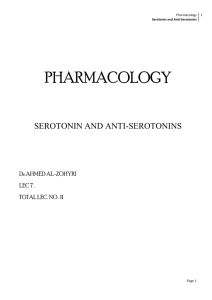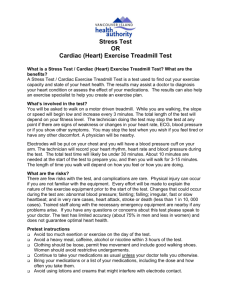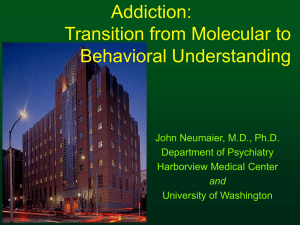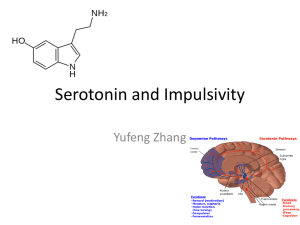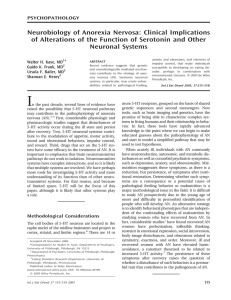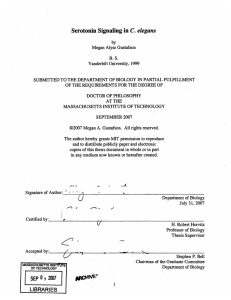Treadmill exercise enhances passive avoidance learning in rats
advertisement
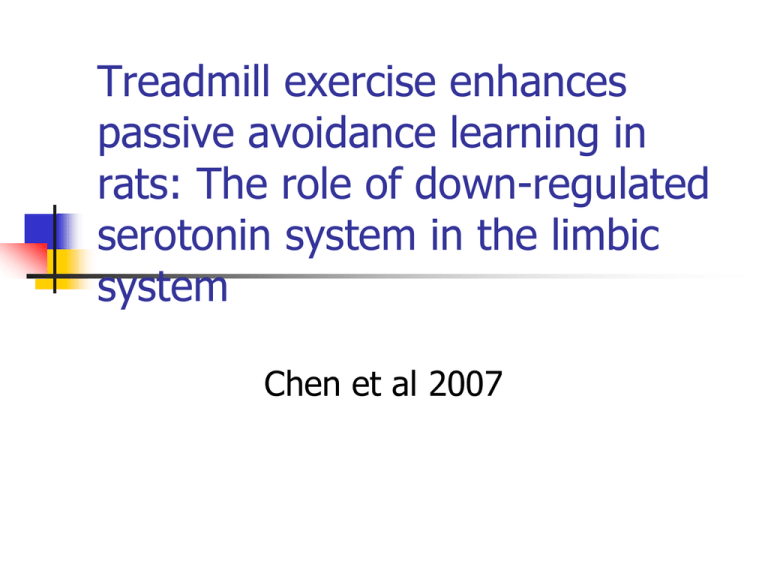
Treadmill exercise enhances passive avoidance learning in rats: The role of down-regulated serotonin system in the limbic system Chen et al 2007 Introduction Treadmill running and running wheel exercise Voluntary wheel running could not rule out possible confounding effects of non-exercise training factors Genetic differences between good runners and poor runners The effects of environment enrichment The temporal relationship between the end of running wheel exercise and the effect measurement is poordefined (Huang et al 2006) Treadmill running: a stressor to rodents? Moderate exercise training with careful animal handling and previous familiarization can minimize the possible stress: acutely upregulate rat hippocampal BDNF gene expression and improve learning. Strenuous exercise without familiarization reduces the BDNF mRNA expression, similar to that exposed to the immobilization stress. (Huang et al 2006) The treadmill-running: a mandatory exercise paradigm with defined exercise intensity and duration. improves passive avoidance (PA) retention and spatial learning. Two avoidance tests Passive avoidance: the animal has to refrain from executing a previous response, such as touching food or water, stepping down or stepping through. (Myhrer, 2003) Active avoidance: the animal has to emit a specific response in order to escape a noxious stimulus. (Cimadevilla et al., 2000) Passive avoidance: the resulting increase in response latency reflects the strength of the memory trace. (Cimadevilla et al., 2000) Serotonin (5-HT) influences a wide range of physiological systems and behavioral functions. 5-HT modulates cognitive processes: fear learning and memory 5-HT1A receptors: 5-HT may impair learning and memory performance via activating 5-HT1A receptors. Mainly 5-HT projections are showed in brain areas important for memory (Meneses and Perez-Garcia, 2007) Regular exercise improves learning and memory capabilities. Exercise alters the 5-HT levels in different brain regions. Are the alterations in 5-HT metabolism or its receptors in various brain regions involved in chronic exercise-enhanced learning and memory? Materials and methods Animals: male Sprague-Dawley rats Treadmill exercise protocol Familiarization: 9m/min for 10 min each day for 5 days Control and exercise groups Exercise: a leveled treadmill at an intensity of 70% of maximal oxygen consumption for 60 min/d, 5d/week for 4 weeks, 12m/min – 15m/min Control: placed in the treadmill without running for 10 min/d No electric shock was applied Passive avoidance apparatus A sliding door between two compartments A stainless-steel floor An illuminating bulb Behavioral tests One-trail step-through passive avoidance test Exploration for 60s each without electric shock The rat was placed in the lighted compartment facing away from the closed door it turned around the door was opened once the rat had entered the dark compartment, the door was closed and an electrical current was delivered Latency to cross into the dark compartment was recorded. (pre-shock latency) Retention of PA performance was tested 24h and 72h afterwards. (testing latency) The role of 5-HT1A receptor: sc injection of 8-OH-DPAT (0.1mg/kg) or vehicle 15 min prior to PA training, PA retention latencies were tested 24 h after training. Pain sensitivity test Rule out the effect of drug-induced alteration in sensory input Test was performed 15 min after sc. injection Rats were individually placed on a hot plate The latency to the first hind paw withdraw was recorded as in index of nociceptive threshold to thermal stimulation Biochemical studies Brain tissue dissection: prefrontal cortex, hippocampus, amygdala Determination of citrate synthase activity in soleus muscles Confirm the exercise training effect Measurement of 5-HT and 5-HIAA by HPLC Measurement pf 5-HT1A receptor and 5-HT2A receptor and 5-HT transporter SERT by Western blotting Statistical analysis Results The exercise training effect the citrate synthase enzyme activity was significantly increased: 1.96±0.01 vs. 1.77±0.02 µmol/min/g wet weight for exercise and control groups. Passive avoidance performance Pre-shock latency was not different between control and exercise groups. 24-h testing retention latency was significantly increased in the exercise group compared to the control group. No significant differences in pre-shock training latencies Exercise significantly enhanced 24-h testing retention latencies The exercise effect was abolished by the administration of 8-OH-DPAT 8-OH-DPAT significantly suppressed the PA performance in both exercise and control groups. Rule out the drug influence to the sensory input: 8-OHDPAT did not significantly affect their pain sensitivity The paw withdraw latency: Saline group: 5.5±0.3s 8-OH-DPAT group: 6.1±0.7s Levels of 5-HT and 5-HIAA in different brain regions The 5-HT level in the hippocampus was significantly reduced in the exercise group at various points after exercise. The 5-HIAA levels in these three brain areas were not significantly affected by exercising training. Protein expression in different brain regions 5-HT receptors The protein expression level of 5HT1A receptor in the amygdala was significantly reduced in the exercise group at all studied time points Treadmill exercise training significantly downregulated 5-HT2A receptor in rat amygdala, but not in hippocampus or frontal cortex. 5-HT transporter SERT Exercise did not significantly alter the protein expression level of SERT in these three regions. Discussion Exercise Training can enhance aversive learning and memory, possibly due to blunted serotonergic inhibition in the brain limbic system. The 5-HT system influenced by the exercise may modulate multiple neurotransmitter systems: cholinergic and glutamatergic etc. Other 5-HT receptors may also modulate the cognitive function: 5-HT1B, 5-HT2. The exercise-decreased hippocampal 5-HT levels were unlikely to be caused by changes in 5-HT uptake or degradation. The impact of stressful experiences? Unlikely Due to the separate groups of rats for PA performance test or monitoring the 5-HTrelated parameters, the treadmill familiarization, moderate exercise intensity and the absence of electric shocks. References 1 Chen et al. (2007) Treadmill exercise enhances passive avoidance learning in rats: The role of down-regulated serotonin system in the limbic system. Neurobiology of Learning and Memory. Doi:10.1016/j.nlm.2007.08.004 2 Huang et al. (2006) Compulsive exercise acutely upregulates rat hippocampal brain-derived neurotrophic factor. Journal of Neural Transmission. 113,803-811 3 Myhrer, T. (2003) Neurotransmitter systems involved in learning and memory in the rat: a meta-analysis based on studies of four behavioral tasks. Brain research reviews. 41, 268-287 4 Cimadevilla et al. (2000) Passive and active place avoidance as a tool of spatial memory research in rats. Journal of neuroscience methods. 192, 155-164 5 Meneses, A. and Perez-Garcia, G. (2007) 5-HT1A receptors and memory. Neuroscience and biobehavioral reviews . 31, 705-727
